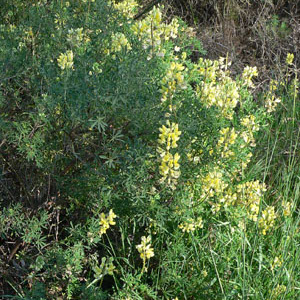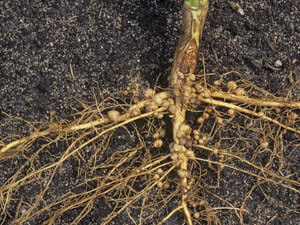Yellow bush lupine (Lupinus arboreus) is a striking and versatile plant that has several uses and qualities. Here are some of its notable features:
- Ornamental Value: Yellow bush lupine is primarily grown as an ornamental plant due to its beautiful and showy yellow flowers. The flowers are arranged in tall, dense spikes that add a splash of colour to gardens and landscapes.
- Native Plant: Yellow bush lupine is native to California and the Pacific Northwest region of North America. As a native plant, it plays an essential role in supporting local ecosystems and provides habitat and food for native wildlife, such as bees, butterflies, and birds.
- Nitrogen Fixation: Like other members of the legume family, yellow bush lupine has the ability to fix nitrogen from the air into the soil. This process improves soil fertility and makes nitrogen available to neighbouring plants, benefiting the overall health of the ecosystem.
- Soil Erosion Control: The deep root system of yellow bush lupine helps stabilize soils and prevents erosion, making it a valuable plant for controlling erosion on slopes and disturbed areas.
- Coastal Gardening: Yellow bush lupine is well-suited for coastal gardening as it tolerates salty sea breezes and sandy soils. It is commonly used in coastal landscapes to add colour and interest to sandy dunes and beach areas.
- Wildlife Habitat: Apart from attracting pollinators, the seeds of yellow bush lupine are an essential food source for many small mammals and birds, contributing to the biodiversity and ecological balance of the region.
- Fire Resistant: Yellow bush lupine has some fire-resistant qualities, and its presence in fire-prone areas can help reduce the intensity of wildfires.
- Drought Tolerance: Once established, yellow bush lupine exhibits good drought tolerance, making it suitable for water-wise landscaping and regions with dry summers.
- Medicinal and Ethnobotanical Uses: Historically, Native American tribes used various parts of the lupine plant for medicinal purposes, although it's essential to exercise caution and consult an expert before using any plant for medicinal reasons.
- Habitat Restoration: Yellow bush lupine is often used in habitat restoration projects to reclaim degraded lands and restore native plant communities.
It's important to note that while yellow bush lupine has many positive qualities, some species of lupines contain alkaloids that can be toxic if ingested. As with any plant, it's essential to use caution and avoid consumption of any part of the plant unless you are certain about its edibility and safety. Always consult with local experts and reputable sources before using plants for any purpose.

